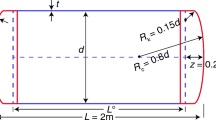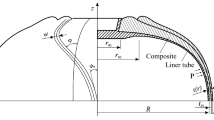Abstract
In this paper, a new composite support made of steel and polymer is proposed for the internal supports of mobile cryogenic vessels. Multilayered design of the steel part in the presented support controls the heat transfer through this part by adding more thermal contact resistance (TCR) to the heat flow path. An analytical model is developed to calculate TCR between layers of the steel part at the support working pressure and temperature condition. A finite element (FE) model is also developed for the proposed support. Thermo-mechanical coupled and transient thermal analysis are performed on the FE model by ANSYS FE code to investigate heat transfer in the polymer and steel parts of the proposed composite support and a support made of polymer block. The effects of dynamic loading frequency and damping on the heat flux passing through the internal support are investigated for the new support design. Comparison of the heat flux results shows that the amount of heat transferred to the cryogenic tank through the internal supports decreases when using proposed composite design instead of polymer blocks not only in the static loading condition but also in the dynamic loading.
















Similar content being viewed by others
References
Timmerhaus, Klaus D, and Richard Reed E (2007). Cryogenic engineering: fifty years of progress. Springer Science & Business Media
Lisowski E, Czyżycki W, Łazarczyk K (2010) Simulation and experimental research of internal supports in mobile cryogenic tanks. Czas Tech Mech 107:175–184
Lisowski E, KŁ WC (2010) Using of polyamide in construction of supporting blocks of cryogenic tanks on example of LNG container. Arch Foundry Eng 10:81–86
Lisowski F, Lisowski E (2019). Thermal and mechanical analysis of the internal support for LNG cryogenic road tanker. In: E3S Web of Conferences. pp. 4–7
Czyżycki W (2015). Modeling of heat flow through multilayer internal supports of cryogenic vessels. Tech Trans Mech 28–34
Lisowski E, WC Ī (2011) Transport and storage of Lng in container tanks. KONES Powertrain Transp 18:193–201
Nishino K (1995) Thermal contact conductance under low applied load in a vacuum environment. Exp Thermal Fluid Sci 10:258–271. https://doi.org/10.1016/0894-1777(94)00091-L
Singhal V, Litke P, Black A, Garimella S (2005) An experimentally validated thermo-mechanical model for the prediction of thermal contact conductance. Int J Heat Mass Transf 48:5446–5459. https://doi.org/10.1016/j.ijheatmasstransfer.2005.06.028
Sridhar M, Yovanovich M (1996) Thermal contact conductance of tool steel and comparison with model. Int J Heat Mass Transf 39:831–839
Sadowski P, Stupkiewicz S (2010) A model of thermal contact conductance at high real contact area fractions. Wear 268:77–85. https://doi.org/10.1016/j.wear.2009.06.040
Hamasaiid A, Dour G, Loulou T, Dargusch M (2010) A predictive model for the evolution of the thermal conductance at the casting-die interfaces in high pressure die casting. Int J Therm Sci 49:365–372. https://doi.org/10.1016/j.ijthermalsci.2009.07.014
Bahrami M, Yovanovich M, Culham J (2005) Thermal contact resistance at low contact pressure: effect of elastic deformation. Int J Heat Mass Transf 48:3284–3293. https://doi.org/10.1016/j.ijheatmasstransfer.2005.02.033
Ventura G, Bianchini G, Gottardi E et al (1999) Thermal expansion and thermal conductivity of Torlon at low temperatures. Cryogenics (Guildf) 39:481–484
www.solvay.com Technical data sheet: Torlon 4203L– Polyamide-imide
www.sdplastics.com Product information: Tecamax SRP – extreme strength without fibre reinforcement. Ensinger Ltd., Pontyclun, Mid Glamorgan, United Kingdom
Woodcraft AL, Martelli V, Ventura G (2010) Thermal conductivity of Tecamax SRP from millikelvin temperatures to room temperature. Cryogenics (Guildf) 50:66–70. https://doi.org/10.1016/j.cryogenics.2009.11.002
Woods SI, Jung TM, Sears DR, Yu J (2014) Emissivity of silver and stainless steel from 80 K to 300 K: application to ITER thermal shields. Cryogenics (Guildf) 60:44–48. https://doi.org/10.1016/j.cryogenics.2014.01.002
Dan-Andrei Ş (2016). Viscoplastic behaviour of polyamides. Intechopen
Cooper M, Mikic B, Yovanovich M (1969) Thermal contact conductance. Int J Heat Mass Transf 12:279–300
Bahrami M (2004). Modeling of thermal joint resistance for sphere-flat contacts in a vacuum
Bahrami M, Culham JR, Yovanovich MM, Schneider GE (2004) Thermal contact resistance of nonconforming rough surfaces, part 1: contact mechanics model. J Thermophys Heat Transf 18:209–217. https://doi.org/10.2514/1.2661
Williamson, JB, Pullen, J, Hunt, RT, and Leonard D (1969). “The shape of solid surfaces,” Surface Mechanics,. In: American Society of Mechanical Engineering. pp. 24–35
Norouzifard V (2014). Experimental study of thermal contact in tool-chip interface and presenting an approach to determine thermal contact conductance. University of Tehran
Greenwood JA, JBP W (1966) Contact of nominally flat surfaces. Proc R Soc A Math Phys Eng Sci 295:300–319. https://doi.org/10.1098/rspa.1966.0242
Ling FF (1958) On asperity distributions of metallic surfaces. J Appl Phys 29:1168–1174. https://doi.org/10.1063/1.1723395
Tabor D (1951) Hardness of metals. Oxford University Press, Oxford
DeSisto TS, Carr FL (1961). Low temperature mechanical properties of 300 series stainless steels and titanium
Miksell RP, Scott RB (1956) Heat conduction through insulating supports in very low temperature equipment. J Res Natl Bur Stand 57:371–378
Mathew M, Shenoy K, Ravishankar KS (2014) Vickers hardness and Specifi c Wear rate of poly propylene reinforced PMMA. Int J Sci c Study 2:71–75
Author information
Authors and Affiliations
Corresponding author
Ethics declarations
Conflict of interest
On behalf of all authors, the corresponding author states that there is no conflict of interest.
Additional information
Publisher’s note
Springer Nature remains neutral with regard to jurisdictional claims in published maps and institutional affiliations.
Rights and permissions
About this article
Cite this article
Norouzifard, V., Hosseini, S.M. & Alizadeh, E. Investigating the effect of metal-polymer internal support on reducing the heat transfer rate of mobile cryogenic vessels. Heat Mass Transfer 57, 269–282 (2021). https://doi.org/10.1007/s00231-020-02950-6
Received:
Accepted:
Published:
Issue Date:
DOI: https://doi.org/10.1007/s00231-020-02950-6




